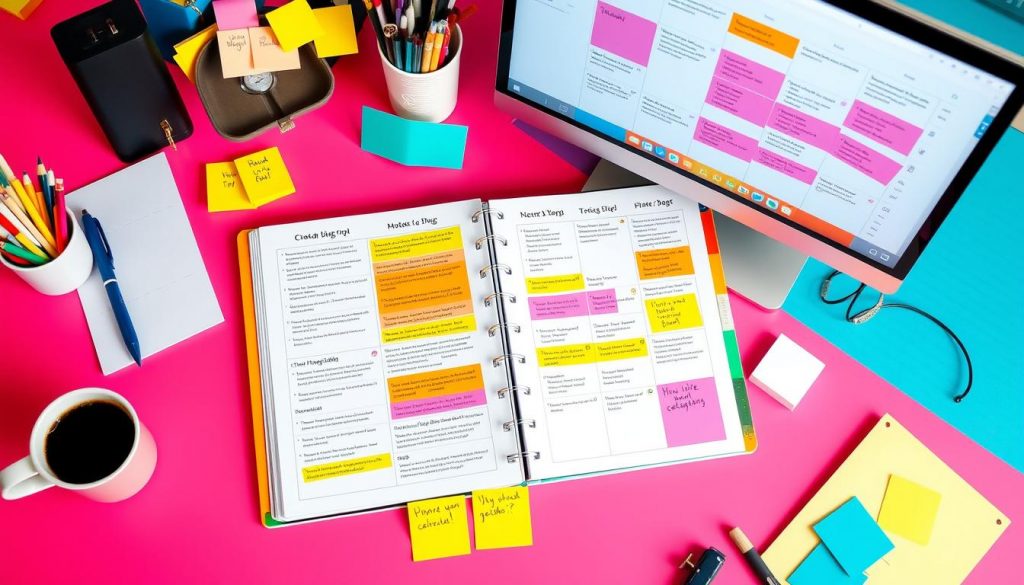Ever wondered how to get more people to visit your blog? Creating a content calendar is key. It helps you plan your posts ahead of time. This way, you can keep track of your work, stay consistent, and save time1.
With a content calendar, you can organize your blog posts better. This boosts your productivity and keeps things tidy. By using these ideas, you can see your blog traffic triple and Pinterest traffic double1.
Having a monthly content calendar makes your strategy more organized. It helps businesses meet their content goals consistently2. By adding these ideas to your plan, you build trust with your readers. This is vital for growing your business in a competitive market2.
With 100 content calendar ideas, you can fill your blogging schedule for months. This keeps your audience engaged2.
Key Takeaways
- Creating a content calendar helps plan and organize content in advance.
- Using content calendar ideas for bloggers can increase blog traffic and engagement.
- A monthly content calendar leads to a more organized and effective strategy.
- Content calendar ideas for bloggers can help build relationships and trust with the audience.
- Blogging schedule templates can increase productivity and improve organization.
- Editorial calendar tips can help ensure consistency and save time.
- 100 content calendar ideas can fill your blogging schedule for months.
Understand the Importance of a Content Calendar
As a blogger, you know how key planning and organization are. A content calendar is a must-have tool. It helps you plan your content better, work more efficiently, and enjoy blogging more. Studies show that 86% of marketers think a content calendar is key for better planning and production3.
A good content calendar helps you focus, manage your time, and feel less stressed. It lets you plan your content in advance, making sure it’s always fresh and interesting. By using a content calendar, you save time and work more efficiently. For instance, you can plan your posts ahead of time with blog post planning strategies.
Some benefits of using a content calendar include:
- Increased productivity and efficiency
- Improved consistency and engagement
- Enhanced SEO and search engine rankings
- Reduced stress and improved time management
Benefits of Planning Ahead
Planning ahead means your content stays relevant, engaging, and consistent. This boosts your website traffic, engagement, and online presence. Studies show that 60% of bloggers with content calendars see a big jump in website traffic and engagement3.
How It Increases Productivity
A content calendar boosts productivity by letting you schedule posts early. This way, you can focus on other blog tasks and spend less time on content creation. By following editorial calendar tips and blog post planning strategies, you can make your content creation smoother. Studies reveal that companies with content calendars are 50% more efficient in creating content4.
Identify Your Blogging Goals
To make a successful content calendar, you must know your blogging goals. These goals should be SMART (Specific, Measurable, Achievable, Relevant, and Time-bound). They should match what your audience needs. Content planning tools help you understand your goals and plan how to reach them. A content calendar is key to organizing and planning your content ahead of time5.
When setting SMART goals, think about what you aim to achieve with your blog. Do you want more traffic, better engagement, or more sales? Knowing your goals clearly helps you create a content strategy that fits. This might include keyword research, understanding your audience, and making buyer personas. Learn more about content planning in this step-by-step guide5.
Setting SMART Goals
SMART goals are essential for a good content calendar. Your goals should be specific, measurable, achievable, relevant, and time-bound. For instance, instead of “I want to increase traffic,” say “I want to increase traffic by 20% in the next 6 months”5. Content planning tools can help you set and track these goals.
Aligning Content with Your Audience
It’s vital to match your content with your audience’s needs. This means understanding what they want, like, and struggle with. Then, create content that speaks to them. With content planning tools and a calendar, you can make sure your content meets your audience’s needs and interests6.
Explore Content Types That Engage Readers
Creating engaging content means using many types. Try blog posts, videos, and infographics to see what your audience likes7. Studies show that tutorials and how-to guides are great because they teach a lot in one post. Videos are also popular, sometimes even more than written content7.
Checklists and infographics are also good because they’re easy to read and share7. Posts about current events and industry news can draw in readers, as people look for this info8. Case studies, inspirational stories, and interviews can also grab attention and boost engagement7. By mixing these types into your content plan, you can get more shares and engagement.
Here are some content types that can engage readers:
- Blog posts
- Videos
- Infographics
- Guest posts
- Collaborations
Using a variety of these content types can make your content strategy strong. This will keep your readers interested and coming back for more.
Remember, the secret to good content planning is to experiment and find what your audience likes8. Try different content types and see what works. This way, you can create a strategy that engages your readers and helps you reach your goals.
Determine Your Posting Frequency
Creating a strategic content calendar is key. It’s important to find the right balance between keeping your audience interested and not burning out. Research shows that 44% of bloggers post between three to six times a month9. This shows that a regular schedule is essential for growing your blog and keeping your audience engaged9.
Think about the type of content you make and how much time you have. Small businesses might post 1 to 4 times a week, while bigger ones might need to post daily or more10. Remember, quality is more important than how much you post. Blogs with better content, even if it’s less often, can do better than those that post a lot but not as well9.
Here are some ideas for your content calendar:
- Weekly posts for timely and relevant content
- Bi-weekly posts for in-depth and detailed content
- Monthly posts for complete and informative content
Success in blogging comes from balancing consistency and quality. By planning your content calendar wisely and considering your resources and audience, you can set a schedule that helps you reach your goals.

Brainstorm Seasonal and Trending Topics
To make a great blogging schedule, brainstorm topics that fit the season and are trending. Use templates and tips to stay organized and focused. This way, you can make content that your audience will love11.
Think about holiday posts, summer ideas, and back-to-school tips for seasonal topics. For trending topics, look at popular hashtags, current events, and viral challenges. For example, food bloggers can make recipes for holidays like Thanksgiving or Christmas12.
Here are some tips for brainstorming seasonal and trending topics:
- Stay current with social media
- Research seasonal keywords and hashtags
- Plan your content with a calendar
- Use templates to stay consistent
By using these tips, you can make a blogging schedule that boosts your blog’s traffic and engagement13.
It’s important to mix evergreen and trending content. This keeps your audience interested in your blog. With the right tools, you can create a successful content strategy11.
| Seasonal Topic | Trending Topic | Example Content |
|---|---|---|
| Holiday-themed posts | Popular hashtags | Recipe for Christmas cookies |
| Summer vacation ideas | Viral challenges | Top 10 summer destinations |
| Back-to-school tips | Current events | 10 ways to stay organized for school |
Create Themed Months for Each Niche
Creating themed months for each niche is a smart blog post planning strategy14. It means planning content around a theme for a month. This makes your content calendar organized and cohesive. Using content planning tools helps you manage this process smoothly15.
Themed months can boost engagement and bring more visitors to your blog14. They also help you post on time and make your workflow more efficient14. Start by listing themes and topics that fit your niche. Then, plan and schedule your content with tools15.
Here are some themed month ideas:
- January: New Year’s resolutions and goal-setting
- February: Valentine’s Day and relationships
- March: Spring cleaning and organization
Choose themes that appeal to your audience to build a loyal following15. Be flexible with your themes and adjust your calendar as needed14.

With the right strategies and tools, themed months can boost your blog’s success14. So, give it a shot and see the impact15?
| Month | Theme | Content Ideas |
|---|---|---|
| January | New Year’s resolutions | Goal-setting tips, productivity advice |
| February | Valentine’s Day | Relationship advice, gift ideas |
| March | Spring cleaning | Organization tips, decluttering advice |
Incorporate User-Generated Content
Creating a content calendar is key for good content planning. Adding user-generated content (UGC) can really help. It makes your audience feel part of a community. This can boost engagement by up to 28%16. Also, 79% of people say UGC greatly influences their buying choices16.
UGC is great for your content calendar because it shows real people using your products. You can use it in many ways, like sharing customer testimonials or reviews. For example, you can start a social media contest where people share their experiences with your brand.
Using UGC can increase engagement and make your brand more known. It shows your brand is trusted and loved. This can help attract more customers. You can also use UGC to support your marketing efforts. Tools like Bazaarvoice, Curalate, and Stackla can help manage and display UGC17.
UGC makes your content more engaging and dynamic. It’s important to track how well UGC works for you. This way, you can see what’s effective and what’s not17. With the right strategy, UGC can boost your brand and drive engagement.
For more tips on content calendars and UGC, check out ContentCory. They have great advice on planning content and using UGC effectively.
Evaluate and Revise Your Calendar Regularly
To keep your blog organized, it’s key to check and update your content calendar often. This means looking at how well your content does and finding ways to get better18. By doing this, you can make your content calendar work better for your readers and help you reach your blogging goals.
A good content calendar can make you more productive by up to 60%19. Making changes to your calendar can also help you meet your business goals by 25% more19. Here’s how to do it:
- Look at your engagement numbers to see what’s good and what’s not18
- Change your posting times to get better engagement and work more efficiently18
- Check if your content strategy matches what your audience likes and needs19
By regularly checking and updating your content calendar, you can make your blog better. This can lead to more people engaging with your content, working more efficiently, and having a more successful blog1819.
Remember, a well-thought-out content calendar is essential for reaching your blogging goals. By following these steps and regularly checking and updating your calendar, you can make a better content strategy. This will help improve your blog’s overall performance19.
| Content Calendar Benefits | Statistics |
|---|---|
| Improved productivity | Up to 60%19 |
| Increased engagement | Up to 32%19 |
| Better campaign effectiveness | Up to 20%18 |
Tools and Resources to Manage Your Calendar
Managing your content planning and distribution can be easier with the right tools. Look for apps and software that make calendar management simple. They should also offer templates for organized scheduling20.
SocialBee is a top choice for social media management. It has a G2 rating of 4.8 out of 5 stars from 429 reviews20. It starts at $29 a month, with a 14-day free trial20. SocialBee works with many platforms like Facebook, X (formerly Twitter), LinkedIn, and Instagram. This makes scheduling and tracking content across channels easy20.
StoryChief is another great tool. It helps manage and publish content on blogs, social media, and newsletters. It has SEO tools, real-time collaboration, and analytics for a better content strategy20.
By using these and , you can plan your content better. This ensures you post consistently and keep your audience engaged.
FAQ
What are the benefits of using a content calendar for bloggers?
What types of content calendars are available for bloggers?
How can I set SMART goals for my content calendar?
What types of content can I include in my content calendar?
How often should I post content according to my content calendar?
How can I incorporate seasonal and trending topics into my content calendar?
How can I create themed months for my content calendar?
How can I incorporate user-generated content into my content calendar?
How can I evaluate and revise my content calendar regularly?
What tools and resources are available to help manage my content calendar?
Source Links
- How to Create a Content Calendar for Your Blog – https://sweethorizonstudio.com/blog/how-to-create-a-content-calendar-for-your-blog/
- 100 Blog Content Ideas for Your 2025 Calendar – https://www.clearvoice.com/resources/100-blog-ideas-for-your-content-calendar/
- Why your blog needs a content calendar and how to create one (plus free template) – https://www.productiveblogging.com/blog-content-calendar/
- The Importance of a Content Calendar | Audrie Dollins – https://audriedollins.com/the-importance-of-a-content-calendar/
- How to Create Your Blog Content Calendar [2024 Edition] – https://seowind.io/blog-content-calendar/
- How to Create a Content Calendar for an Entire Year | Plan Blog Content – https://eliteblogacademy.com/yearly-blog-content-plan/
- 40 Engaging Types Of Blog Posts & Content You Can Create – https://bloggingwizard.com/content-types/
- 50 Types of Blog Posts: Engage Readers & Grow Your Brand – https://optinmonster.com/73-type-of-blog-posts-that-are-proven-to-work/
- How to Create a Content Calendar That Works for Your Blog – Blogger Hangout – https://bloggerhangout.com/createcontentcalendar/
- Find the Blog Posting Frequency that Works for You – https://expresswriters.com/blog-posting-frequency/
- Crafting Your Brilliant Blog Ideas for a Fresh Content Calendar – https://quickcreator.io/seo/crafting-brilliant-blog-ideas-fresh-content-calendar
- Seasonal Traffic and How to Capture It for Your Blog – https://problogger.com/seasonal-traffic-and-how-to-capture-it-for-your-blog/
- Blog Strategy and Seasonal Content: What You Need to Know – https://jessicathiefels.com/blog/blog-strategy/
- Theme Months: The Key to A Successful Content Strategy – https://springinsight.com/better-content-writing-with-theme-months/
- How to Create a Blog Content Calendar – Robyn Roste – https://robynroste.com/create-blog-content-calendar/
- Maximizing the impact of user-generated content on your blog – https://aicontentfy.com/en/blog/maximizing-impact-of-user-generated-content-on-blog
- How can you use user-generated content in your content calendar? – https://www.linkedin.com/advice/3/how-can-you-use-user-generated-content-your-calendar-1rtwc
- 11 Blog Content Calendar Templates for Content Marketers, Bloggers, and Editorial Teams + The WordPress Plugin and 3 Tools – https://jaysearch.com/blog/blog-planning-templates
- Boost Your Productivity, Reduce Stress, and Achieve Business Goals with a Content Calendar – https://meghanmonaghan.com/content-calendar/
- 5 content calendar tools for sharing content everywhere – SocialBee – https://socialbee.com/blog/content-calendar-tools/











